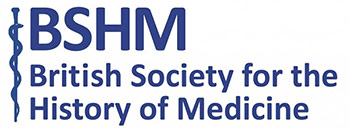


“In Sickness and in Health: exploring medical history collections"
Wednesday 12th September 2018 @ the Wellcome Collection.
Symposium programme and links to presentation images.
13.30-13.45 Registration
13.45 Welcome and Introduction Chris Derrett, President BSHM
13.50-15.35 Mini Talks – each talk will be 10 minutes with 5 minutes for questions/discussion
13.50 - Clare Button, Archivist, University of Edinburgh Library and Archives
'Body Language': new perspectives for the history of medicine
Click here to see presentation images
'Body Language' is a Wellcome Trust Research Resources project based around archives relating to movement, dance and physical education in Scotland from the late nineteenth century to the present day. A partnership between the Centre for Research Collections, University of Edinburgh and the Fergusson Gallery, Perth, this project will catalogue, conserve and selectively digitise the records of Scottish Gymnastics and Dunfermline College of Physical Education and the archives of movement and dance pioneer and physiotherapist Margaret Morris (1891-1980). This talk will focus on the currently untapped potential of these collections for the history of medicine and related areas, including such topics as health and fitness education, physiotherapy and the remedial aspects of movement and dance.
14.05 - Briony Hudson, Freelance Museum Curator
“This vexed question”: displaying women in Medicine
Click here to see presentation images
Briony will discuss the challenges in creating an exhibition about the long history of women in medicine, opening at the Royal College of Physicians on 19 September 2018. When your own collection only tells a very partial story, what are your next steps?
14.20 - Kurt Jameson, Royal College of GPs and Richard Allen, UCL
The Hoxton Health Collective - cataloguing and curating a unique general practice archive.
Click here to see presentation images
Richard Allen was part of a team of UCL masters students that recently turned the papers of the Hoxton Health Collective, a former general practice in East London run according to collective ideals, into an online exhibition. Kurt Jameson, archives trainee at the Royal College of General Practitioners, has also catalogued these papers. Together they will present what they believe can be learned from the archives of this radical experiment in the running of a general practice."
14.35 - Sarah Lowry, Oral History Officer, Royal College of Physicians ‘Voices of Medicine’ project
Recording and re-using oral histories:
Click here to see presentation images
This talk with provide an overview of the strengths of oral history as a historical source, the major collections of medical oral histories in UK institutions and how to access these. It will also cover the benefits of carrying out your own oral history interviews and the main issues that you should consider when conducting this kind of research. Information on oral history training courses and the major oral history archives will be included in the delegates pack.
14.50 - Kim Walker, PhD candidate Royal Botanic Gardens and Royal Holloway
A collection of cinchona bark at Kew Gardens
Click here to see presentation images
The vast resource of objects, correspondence and publications that lie within the archives and collections at the Royal Botanic Gardens, Kew, represent 250 years of plant collecting and include considerable data about plant-based medicines. Within Kew’s Economic Botany Collection lies the largest known collection of 18th and 19th century cinchona bark, the source of the anti-malarial alkaloid quinine. These barks represent the efforts of the British to understand the complex botany and chemistry of this South American tree, and their endeavours that led towards government-controlled cultivation in India. These objects and their associated archives are of great interest to the historian on how this medicine developed, and its impact on empire and colonisation. Not only do these specimens give unique insights for the historian, but they are of interest to the future of science too, and new techniques are allowing new discoveries to be made.
15.05 - Louise Williams, Archivist, Lothian Health Services Archive
Medical Records Revived
Click here to see presentation images
Lothian Health Services Archive (LHSA) has recently completed two medical case note cataloguing projects, intellectually opening up under-used research resources using innovative cataloguing. Louise Williams will briefly introduce the projects and their online catalogues, which describe individual records without identifying patients.
15.20 - Natasha McEnroe, Keeper of Medicine, The Science Museum
Displaying Medicine: The New Galleries at the Science Museum, London
Opening in autumn 2019, the new Medicine Galleries at the Science Museum will be the largest display of the history of medicine in the world. Displaying both the incredible historic collection of Henry Wellcome alongside the more contemporary collections of the Science Museum, the galleries will take up most of the first floor of the museum in South Kensington. Natasha McEnroe will share her hopes, joys and fears of leading a project of this scale and will discuss the long-term impact that these galleries will have on medical humanities research.
15.35 - 16.05 Tea/Coffee/Networking Break
Click here for interval presentation on Leprosy Postal items in the collection of Dr Bill Dibb
16.05 - 16.50 Panel Discussion
Facilitator/Chair - Clare Button (University of Edinburgh Library and Archives)
Panel:
- Geoff Browell - Archivist - Kings College
- Carina Phillips - Curator, RCS
- Briony Hudson - Freelance museum curator
- Ross McFarlane - Research Engagement Officer, Wellcome Library
- Alice White - Digital Editor, Wellcome Collection
Discussion topics may include:
- Widening ambition in using collections.
- Encouraging users/non-users to access collections.
- Alternative ways of presenting history of medicine research - blogs, social media, websites, videos, podcasts, Wikimedia, etc.
- Preserving and saving private and public collections.
- What’s the point of medical museums?
16.50-17.00 Summary and Concluding remarks
